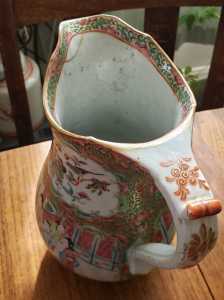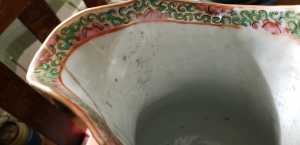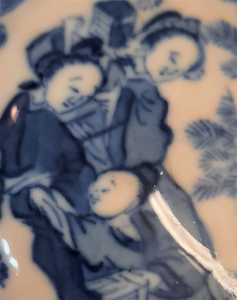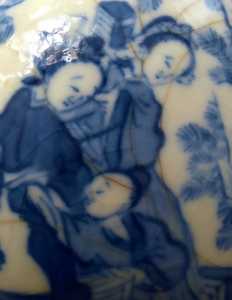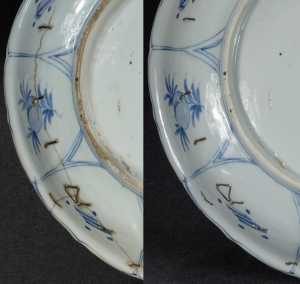The Chinese and Asian Art Forum. For Fans, Collectors and Dealers.
 Basic Rules For the BidAmount Asian Art Forum: Talk about whatever you want. You can even discuss and offer things that are for sale if they are authentic. Maximum image file size per post is 2 MB. Images of 700pxl x 700pxl are optimal if saved at a medium resolution. Be respectful of others and enjoy yourself. Click the YouTube link for a brief tutorial on using the forum. You can also EMBED Videos by cutting and pasting from You-Tube, Vimeo etc.
Basic Rules For the BidAmount Asian Art Forum: Talk about whatever you want. You can even discuss and offer things that are for sale if they are authentic. Maximum image file size per post is 2 MB. Images of 700pxl x 700pxl are optimal if saved at a medium resolution. Be respectful of others and enjoy yourself. Click the YouTube link for a brief tutorial on using the forum. You can also EMBED Videos by cutting and pasting from You-Tube, Vimeo etc.
NOTE: To post an item or add a new post, click open the category title from the FORUM LIST, and CLICK the Blue ADD TOPIC button.
Hi Everyone,
I recently acquired a rose medallion pitcher that is marred with mould-grey spots on several of the white areas, including the inside. I tried cleaning with warm water and soap to no avail. I know Peter has mentioned that cleaning up cracks and other dirty niches in porcelain can be done with peroxide. Have you done this before? What is your advice? Is it safe for the gilding and enamels to use peroxide to clean rose medallion?
Would love to hear of your experiences & advice. Thank you!
-Steve
Peter mentioned recently how to do it in a video, you have to soak it in a plastic tub and it was not just over the counter peroxide, but it would not harm the enamels but he was talking about making discolored cracks on surface less noticeable. Hopefully someone will know the exact process, good luck, if you do it then soak in water for an equal number of days after soaking in the peroxide. I think you can buy the super strength peroxide from a beautician (according to Martha Stewart years ago), but I think Peter may have recommended a hardware store. Maybe just email him. Sharon
So far I have only tried it on blue and white. I put a drop of ammonia into a 6%/20 vol. peroxide. The ammonia helps but isn’t absolutely necessary. For hairlines I drench strips cut from cosmetic cotton pads and put them on the discoloration then cover with cling film. I renew the peroxide after some hours if necessary. As Sharon said soaking in water for a day or two afterwards is important. In my opinion overglaze colors should be no problem but I would avoid gold areas. If the discoloration is on white areas only you can work with small pieces of cotton pad that you cut accordingly.
Birgit
Thank you. This being a rose medallion piece there's no avoiding the gold except on the inside, and even there, there is a professional repair with gilding.
However, as I examine it closely, the grey spots seem to be under the glaze, making me think it's just a quirky firing flaw. I may not be able to remove them at all!
You can try to clean the spotted areas on the inside by using peroxide drenched cotton pads locally. As long as you keep out of the gold there’s no problem
Birgit
@steve Might just be impurities in the clay, I would just live with it instead of messing about with the gilded areas.
I never used peroxide, because it is yellowing in time if it can’t be removed completely. A chemist friend did suggest me to neutralize the remnants of peroxide with some acid, like the lemon juice; thus I thought that all this means that something may remain, and so I think that it is better to remove than leave something in the cracks.
What I do is soaking the whole piece in ambient temperature water added with enzyme-based dish detergent (basically, all modern dish detergent contains enzymes) for a day or night. Then inspect it, and if necessary, let it soaked a further day in the same bath.
After this, in some cases the treatment will not have effect, but in most cases the staining of the crack will appear more faded. At that point, I rinse the piece with fresh water and clean the crack with a water pik, a family dental water jet. The pressure of the jet will remove the softened stain, and in 90% of cases the crack or hairline will be completely cleaned, the staining full removed.
Before doing this method, be aware that the unglazed areas, i.e. the foot, will turn pure white. That means that the very pale brownish color that we think is the normal color of the paste is indeed dirty. Thus, the pure white foot will look as it was when brand new. Many will not like that. If you want to preserve the current aspect of the foot, then the soaking of the foot must be avoided.
In my experience, all type of enamels are very stable. I have used paint stripper, a very strong agent, several times and never had problems, including on gilded areas.
I think that what happened inside your pitcher is staining under the glaze, having the staining substance penetrated the glaze through burst bubbles holes. This is almost impossible to remove, because, due to the almost perfect impermeability of the porcelain, it took many years for staining it, hence the same is expected for the penetration of the cleaning agents.
Regards,
Giovanni
Dear Giovanni,
This is very helpful information. Thank you!
I agree that the spots on the white part will be impossible to remove. They're not just inside but outside too in many parts.
I will keep your advice in mind if I ever have to clean an item in the future.
Regards,
Steve
That's a good suggestion. I'll look into the cost of trying that, but as I look at the grey spots under a magnifying glass, they seem to be under a smooth surface of glaze so I agree that they may be porcelain clay impurities.
Interestingly enough, I just got finished using hydrogen peroxide to clean my porcelain box...I will post a few pics tomorrow. In 2 days, the dark stains on the crackle has completely disappeared, and other stains have been 99% removed as well.
So, here is what I can tell you from my experience...
I've use hydrogen peroxide to clean Japanese prints on a regular basis, and I learned the technique from an accredited museum conservator. So, the process works the same with porcelain, but it takes a bit longer since porcelain is not as porous as paper.
The key is NOT the strength of the peroxide... it is the exposure to UV light!
I use generic brand 3% strength peroxide. Just fill a clear plastic container and set the object you're bleaching into the peroxide, then set in direct sunlight. I have never tried using a UV light, but I suppose it should work.
UV light acts like a catalyst and you'll see small bubbles form on the surface of the porcelain object fairly quickly. If you see the bubbles...it's working! If not, it might be working, but on a very slow rate and/or small scale.
Once you've achieved the desired color (or lack there of), then I suggest removing the object from the peroxide bath, and leaving the object in the sun for a few days to allow all remaining peroxide to fully dissipate from the porcelain. I suppose soaking the vessel in water will also help to dilute and dissipate the peroxide, but I've never needed to do this with porcelain.
However, I do soak all of my Japanese prints in distilled water in order to remove excess peroxide, sometimes twice over several days, before I dry them. Remaining peroxide in paper can cause the paper to whiten to a level that does not look natural.
This is probably a stupid question, but I assume you dilute the peroxide? Or does it get dabbed on neat?
What about things like Vanish or Milton, will they work? Or some of the Oxygen based cleaners?
Sorry for all the questions, I am always nervous of cleaning other than soap and water but some pieces do need hairline cleaning.
Dear Greeno,
let me joke about another semantic interpretation 😊.
You said that “In 2 days, the dark stains on the crackle has completely disappeared, and other stains have been 99% removed as well.”
It is not exactly that way. The stains have not been removed in case of peroxide; they have just changed the color, but the substance is still there. It is exactly the reason why I prefer the bath with enzyme-based detergent and the water jet.
It must be considered that a hairline must be fixed. If not fixed, the crack will inevitably progress over time.
Then, after the cleaning, the hairline must be in conditions to suck the glue. If the staining substance (most of it is fat for handling) has been removed, then the glue will better penetrate and, most important, better adhere to cleaned surfaces. If the fat is still there, and just whitened, the gluing process will be less effective.
Anyway, as I said before the trick is not always effective, it depends on the type of the staining substance, but it works well in the majority of cases. Hence I suggest to try it before, being in fact simple and less dangerous, and switch to more aggressive agents only if necessary.
I am adding a picture showing the before/after the effect on a kraak dish.
As said before, note that the foot too has been whitened, as well as the chalk filling of the holes for the staples. This may not be liked by everyone, but the fact is that the technique used has not been based on changing the color, but simply on removing the dirty instead. So the appearance of the foot must be same that it had when fresh from the kiln.
Regards,
Giovanni
Thanks for visiting "The BidAmount Asian Art Forum | Chinese Art"
If you sell on eBay, or have a shop feel free to post images and descriptions and links.
Check back often for discussion about the latest news in the Chinese art and antique world. Also find out about the latest Asian art auctions at Sotheby's, Christie's, Bonhams and Tajans.
Auction results for: fine porcelain, ceramics, bronze, jade, textiles and scholar's objects. As well as Japanese, Thai, Vietnamese and other Asian cultures.
Thank you,
Peter Combs
Topics and categories on The BidAmount Asian Art Forum | Chinese Art
Kangxi vases, Kangxi dishes and chargers, Kangxi ritual pieces, Kangxi scholar's objects, Qianlong famille rose, Qianlong enamels, Qianlong period paintings, Qianlong Emporer's court, Fine porcelain of the Yongzheng period. Chinese imperial art, Ming porcelain including Jiajing, Wanli, Xuande, Chenghua as well as Ming jades and bronzes.
The BidAmount Asian Art Forum | Chinese Art
A free Asian art discussion board and Asian art message board for dealers and collectors of art and antiques from China, Japan, Korea, Thailand, Cambodia, Vietnam and the rest of Asia. Linked to all of the BidAmount Asian art reference areas, with videos from plcombs Asian Art and Bidamount on YouTube. Sign up also for the weekly BidAmount newsletter and catalogs of active eBay listing of Chinese porcelain, bronze, jades, robes, and paintings.
The art of calligraphy - and for the ancient Chinese it certainly was an art - aimed to demonstrate superior control and skill using brush and ink. Calligraphy established itself as one of the major Chinese art forms during the Han dynasty (206 BCE - 220 CE), and for two millennia after, all educated men were expected to be proficient at it.
The Museum’s collections of Asian art span nearly five millennia and encompass the cultures of China, the Himalayas, India, Japan, Korea, and Southeast Asia. In 2007, the Museum launched an initiative to create dedicated galleries for the collection, beginning with a gallery for the arts of Korea ...
Chinese art is full of symbolism, in that artists typically seek to depict some aspect of a totality of which they are intuitively aware.
China Online Museum is the finest online museum of Chinese art. It features Chinese calligraphy, painting, ceramics, bronzes, carving, and other artworks.
Chinese Ceramics & Works of Art. Overview Upcoming auctions Contacts Auction results ... Christie’s sales of Chinese ceramics and works of art showcase centuries of Chinese history. Held throughout the year in London, New York, Paris and Hong Kong, they attract a wide audience of collectors and connoisseurs vying for pieces as diverse as ...
Explore Asian Art Week. Contact the Specialist Department. Chinese Paintings ... Senior Specialist, Head of Sale. [email protected]. Tel:+1 212 641 5760. Bid in-person or online for the upcoming auction:Fine Chinese Paintings on 10 September 2019 at New York. Bid in-person or online for the upcoming auction:Fine Chinese Paintings on 10 ...
Discover an abundance of must-see art from all corners of a vast continent at Christie’s NY Asian Art Week. From contemporary classical and Chinese paintings to works with exemplary provenance from the Art Institute of Chicago, our Rockefeller Paza galleries will be full of ancient treasures and contemporary masterworks in a salute to the vibrant arts of Asia.
Sold to benefit The Art Institute of Chicago’s Asian Art Acquisition Fund, the sale features 84 lots with a focus on Ming and Qing porcelains, and offers a rare insight into the taste for collecting Chinese ceramics and works of art in the Midwest from the end of the 19th century through the 1980s. Highlights include two Wanli wucai garlic-head vases, a Qianlong mark and period, blue and ...
Specialist, Chinese Paintings, Christie's London Dr Malcolm McNeill is a Specialist in Chinese Paintings at Christie’s, based in London. He previously worked as an assistant curator of the Chinese collections and the Victoria and Albert Museum in London, as a researcher at the British Museum, and as a translator and tour guide at the National Palace Museum in Taipei.
The Christie's Education 2020 Conference: The Chinese Art Market 18 Jun 2019 Christie’s Education is delighted to announce our first international academic conference in Asia which will take place in Hong Kong from 26-27 November 2020 at the Hong Kong Convention and Exhibition Centre and will run in parallel with Christie’s Hong Kong Autumn Auctions.
The summer Chinese Art sale in Hong Kong will feature works of art from several private collections, including Qing porcelains and textile from the collection of the legendary Chinese art dealer A. W. Bahr (1877–1959), fine gilt bronze Buddhist sculptures from an old Hong Kong collection, an East Asian collection of Qing dynasty wine cups and jades, and a Japanese collection of Song ceramics ...
Sotheby's Chinese Works of Art Department holds two auctions each year in London, New York, Hong Kong and Paris.
Chinese Art - View Auction details, bid, buy and collect the various artworks at Sothebys Art Auction House.
With more than 340 Chinese works of art dating from the Neolithic to the Republic periods, highlights of this sale include a selection of Qing Imperial monochromes from the collection of Arnold and Blema Steinberg, early ceramics from the Art Institute of Chicago and Chinese porcelain and works of art from the collection of Henry Arnhold.
Results: Sotheby's Asia Week achieved $52.4 million in six strong auctions, exceeding pre-sale estimates. With 76.5% of lots sold and 60.3% of lots surpassing high estimates, the Asian art sales at Sotheby's indicate continued collector interest in the finest works of art from China, India and and the Himalayas.
Today's sale of Important Chinese Art will proceed as planned with sessions at 10 AM and 2 PM EDT. Sotheby's will be monitoring the weather conditions throughout the day and will be available to coordinate alternative bidding options should conditions make it difficult for clients to attend the auction in person.
Bonhams Chinese Art department is renowned for offering the finest works of art representing the richness and breadth of China's artistic heritage, particularly Imperial porcelain, white and spinach green jades, cloisonné and Buddhist art. Specialised international auctions are held globally, including London, Hong Kong and San Francisco.
Bonhams : Chinese Works of Art We use cookies to remember choices you make on functionality and personal features to enhance your experience to our site. By continuing to use our site you consent to the use of cookies. Please refer to our privacy and cookie policies for more information.
Bonhams Fine Art Auctioneers & Valuers: auctioneers of art, pictures, collectables and motor cars. We use cookies to remember choices you make on functionality and personal features to enhance your experience to our site. By continuing to use our site you consent to the use of cookies. ... Chinese Art (US) General enquiries
Bonhams : Fine Chinese Art We use cookies to remember choices you make on functionality and personal features to enhance your experience to our site. By continuing to use our site you consent to the use of cookies. Please refer to our privacy and cookie policies for more information.
Bonhams Fine Art Auctioneers & Valuers: auctioneers of art, pictures, collectables and motor cars Bonhams : Asian Art We use cookies to remember choices you make on functionality and personal features to enhance your experience to our site.
Bonhams are international auctioneers of fine Chinese and Japanese art. We specialise in rare Imperial and Export Chinese ceramics and works of art, as well as Japanese ceramics, fine and decorative works of art from the Neolithic Period to the 20th century. View on map
Bonhams Fine Art Auctioneers & Valuers: auctioneers of art, pictures, collectables and motor cars. We use cookies to remember choices you make on functionality and personal features to enhance your experience to our site. By continuing to use our site you consent to the use of cookies. ... Asian Art Bonhams. Work. 22 Queen St.
